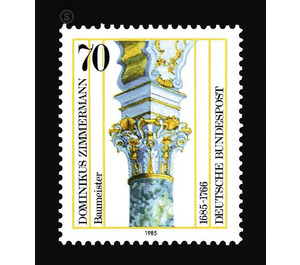300th birthday of Dominikus Zimmermann - Germany / Federal Republic of Germany 1985 - 70 Pfennig
Theme: Architecture
| Country | Germany / Federal Republic of Germany |
| Issue Date | 1985 |
| Face Value | 70.00 |
| Color | multi-colored white |
| Perforation | K 13 3/4: 14 |
| Printing Type | 4-color rotogravure |
| Stamp Type | Postage stamp |
| Item Type | Stamp |
| Chronological Issue Number | 1124 |
| Chronological Chapter | GER-BRD |
| SID | 322031 |
| In 35 Wishlists | |
Master builder and stuccoer Dominikus Zimmermann created one of the most famous pilgrimage churches with the »Wies«. For us today, it is the epitome of South German Rococo. This style name derives from the rocaille, the main ornament of shellfish developed between 1735 and 1760/70. Zimmermann's achievement within this rococo was a fusion of the previously clearly defined genres of architecture, image and ornament. This allowed architecture to assume pictorial and ornamental qualities. Dominikus Zimmermann was born in Gaispoint near Wessobrunn on June 30, 1685. Dominikus Zimmermann grew up in an area that produced the most important furnishing artists of the Bavarian 17th and 18th centuries. Here he received his first artistic suggestions. Further impressions of the master builder, stucco artist and painter Johann Jakob Herkommer led to Zimmermann's early works, as they were created from 1708 in the monastery church Fischingen in the Swiss canton of Thurgau and then until the twenties, especially in the Swabian area: stucco marble altars, the former craftsmanship perfection already recognize features of the later architect. These are the soft modeling of substances, the curved lines of entablature and pedestal parts. The material of these altars alone, the stucco marble, represents a paradox to an architectural task at first, and at the same time also shows the principles of 18th century art and especially that of Dominic Zimmermann. From initially soft gypsum compound, solid structures emerge, eventually growing architectural constructions, which, however, can only be experienced in their ornamental modeling as a whole. The construction of the monastery church Maria Medingen (1716) was Zimmermann's first assignment as an architect. Here, as in the later works, the Domikanerinnenkirchen Landsberg (1720 to 1725) and Siessen (1726 to 1728) and the parish church in Buxheim (1725 to 1727), he took over motifs of the Vorarlberg building school. Architectural structures were set up in simple auditoria - pilasters, which in Siessen turned into pillars, and in the pilgrimage church of Steinhausen (1728 to 1733) were even able to train as free pillars. Zimmermann has always been clearly divided between this set architectural scaffold and the outer shell. For him, Wand was no longer a tectonic mass in these early works, in which the function of carrying and burdens was expressed; on the contrary, it was treated as an artistic, hand-shaped substance. The ornamental incision of curved window forms finally created a system of differentiated light values, reducing the wall to an immaterial, membrane-like surface. With the construction and stuccoing of the Wieskirche (1744-54), Dominikus Zimmermann, supported by the frescoes of his brother Johann Baptist, created a culmination of European art of the 18th century. At the same time, the endpoint of a style was reached, in which architecture, fresco and ornament mutually condition each other, but in their entanglement they are already attacking each other. Thus, the paired columns of the oval lay room are no longer canonical architectural elements, but hybrids formed from the ornamental slicing of the square pillar and the pillar. The furthest away from traditional architectural concepts is Dominikus Zimmermann in the choir room. Arched arches above blue stucco marble columns and white-and-gold capitals, which, recognizable in their cut and lines already at the base as an ornamental mass, for example as a built-up band movement, are already starting to run downwards in freely hanging seed beads after a short arc run. Architecture is no longer ornamented here, but is itself a substantiated ornament. The openings in the ceiling seem to have been due to the softening of the tectonic substance, which begins to move slowly downwards from the bulge and immediately "blooms" into rocailles at the "rupture point". These seemingly accidental openings reveal the view of the small frescoes behind them. At the same time, they form the framework with their rocaille swirls, as they create transitions as an ornamental zone in the choir fresco. Thus, the template for this stamp - a capital and stucco detail from the presbytery of the Wieskirche - refers to an original solution of Dominic Zimmermann and is a worthy reference to its performance as a stucco architect. (Text: Magister Robert Stalla, University of Munich, Institute of Art History)


